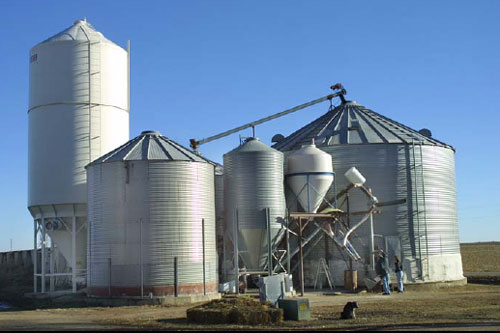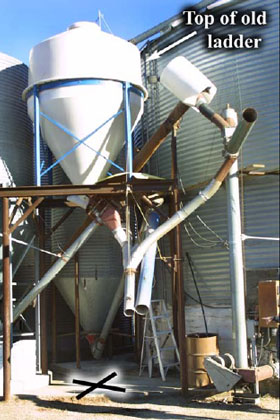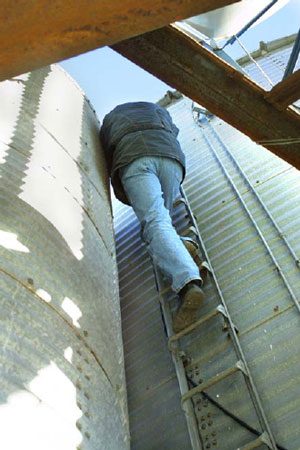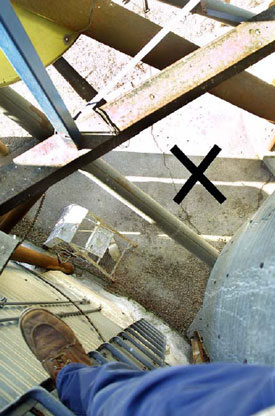

Farmer Falls to His Death from Grain Bin Ladder
 |
| Photo 1 – Group of grain
bins at the farm, facing Southeast. |
RECOMMENDATIONS based on our investigation are as follows:
INTRODUCTION
In June 2002 a 52-year-old Iowa farmer was killed when he fell off the ladder of a grain bin on his farm. The Iowa FACE program was informed of this a few months later, and two investigators made a site visit to the farm later that year. The bins were photographed, and the victim’s wife was interviewed.
INVESTIGATION
The grain bin involved in this injury (to the right in Photograph 1) was built in 1986. Other bins were added to this facility in 1988-89. The facility had four corn bins and additional smaller bins for feeds and supplements. Each bin had an auger connecting to the central auger, which was used to feed the grinder mixer to mix corn, soy meal, alfalfa, minerals, and other supplements for livestock feed.
The original ladder for the large bin was located on the north side, the top barely visible in Photograph 2. The ladder was about 24 foot (7.2 m) tall. A smaller bin had been constructed very close to this ladder, so that one had to climb the ladder at a slight angle (see Photograph 3). The ladder was used frequently to reach the access door on top of the bin. There was no cage around the ladder, nor were there other means to prevent or arrest falls from the ladder.
 |
|
Photo 2 – Side view of old grain bin ladder and concrete pad where the victim fell. |
On the day of the incident, the victim was working with his 17-year-old son, mixing and grinding feed as they had done many times in the past. The large bin was about 2/3 full of corn, and contained some clumps of out-of-condition corn. Both the farmer and his son had been up in the bin that morning, apparently checking the level and condition of corn and breaking up any clumps that could clog up the auger. The son came down the ladder first, followed by his father. About half way down, the farmer apparently slipped and lost his grip, and fell backwards off the ladder. He may have hit an auger first (visible in Photograph 4) as he fell over to the other side of the auger, hitting his head on the concrete pad below (location marked with an X). He was stunned, but conscious, and walked to a nearby lawn to lie down.
The son was greatly alarmed, and called 911 against his father’s wishes. An ambulance transported the man to a local hospital, and arrangements were made to transfer him to a larger hospital by helicopter. Within a few hours, however, the man exhibited symptoms of severe intracranial injury, and he lost consciousness, rapidly deteriorated, and died before surgery could be arranged.
After this incident, new grain bin ladders (outside and inside the bin) were added to the west side of the bin (see Photo 1). These new ladders are similar to the old ones, but have no obstructions and no concrete pad underneath. A new access door and ladder/walkway to the central opening was also added.
 |
 |
|
Photo 3 – View from the ground looking up the old grain bin ladder. |
Photo 4 – View from the top of the ladder, showing area where the farmer fell. |
CAUSE OF DEATH
The cause of death from the Medical Examiner’s report was “closed head trauma” due to fall from grain bin.
RECOMMENDATIONS / DISCUSSION
Recommendation #1 Tall grain bin ladders should be constructed according to standards for fixed ladders.
Discussion: 29 CFR 1910.27 describes requirements for fixed ladders. Fixed ladders for grain bins and other structures that are taller than 20 feet (6 m), must be equipped with protective cages. Tall ladders must also have landing platforms with no more than 30 feet (9 m) of unbroken length (20 feet (6 m) for ladders with no cage). These and other required features for ladders are not enforced on family farms, and most farm grain bin and silo ladders do not meet these requirements. However, to avoid deadly falls from grain bins, silos, and other tall structures, these standards should be followed when constructing fixed ladders.
Recommendation #2 Grain bin ladders should be free of obstructions.
Discussion: In this case the ladder did not have adequate clearance to climb the ladder in a normal fashion. The newer grain bin added next to the original grain bin was too close to the ladder, and forced the worker to lean to his/her right side when climbing. This may compromise the worker’s ability to hold on to the ladder and have secure footing at all times. 29 CFR 1910.27 also specifies how much clearance is need around the ladder, and these specifications should be followed regardless whether the standards are enforced on farms or not.
Recommendation #3 Fall-arrest systems should be developed for grain
bins and they should be an integral part of the grain bin design.
Discussion: Grain bins and silos have tall ladders which may be used frequently in all weather conditions. Falls from these ladders are common, and solutions are needed to reduce fall injuries. Fall arrest systems have been developed for many overhead work applications. Similar solutions should be developed for grain bins and silos. These systems should protect the worker when climbing outside and inside the structure. An appropriately designed fall arrest system could also be helpful in preventing suffocations in flowing grain. A permanently attached, readily available fall arrest system should be part of each grain bin and silo to prevent fall injuries. Engineering intervention research should be conducted to develop and evaluate such systems.
REFERENCES
CFR 1910.27 Fixed Ladders
CFR 1910.272 Grain Handling Facilities
Fatality Assessment and Control Evaluation
FACE
FACE is an occupational fatality investigation and surveillance program of the National Institute for Occupational Safety and Health (NIOSH). In the state of Iowa, The University of Iowa, in conjunction with the Iowa Department of Public Health carries out the FACE program. The NIOSH head office in Morgantown, West Virginia, carries out an intramural FACE program and funds state-based programs in Alaska, California, Iowa, Kentucky, Massachusetts, Michigan, Minnesota, Nebraska, New Jersey, New York, Oklahoma, Oregon, Washington, West Virginia, and Wisconsin.
The purpose of FACE is to identify all occupational fatalities in the participating states, conduct indepth investigations on specific types of fatalities, and make recommendations regarding prevention. NIOSH collects this information nationally and publishes reports and Alerts, which are disseminated widely to the involved industries. NIOSH FACE publications are available from the NIOSH Distribution Center (1-800-35NIOSH).
Iowa FACE publishes case reports, one page Warnings, and articles in trade journals. Most of this information is posted on our web site listed below. Copies of the reports and Warnings are available by contacting our offices in Iowa City, IA.
The Iowa FACE team consists of the following: Craig Zwerling, MD, PhD, MPH, Principal Investigator; Wayne Johnson, MD, Chief Investigator; John Lundell, MA, Coordinator; Risto Rautiainen, PhD, Co-Investigator, Martin L. Jones, PhD, CIH, CSP, Co-Investigator, and John Kraemer, PA. From the Office of The State Medical Examiner.
To contact Iowa State FACE program personnel regarding State-based FACE reports, please use information listed on the Contact Sheet on the NIOSH FACE web site Please contact In-house FACE program personnel regarding In-house FACE reports and to gain assistance when State-FACE program personnel cannot be reached.